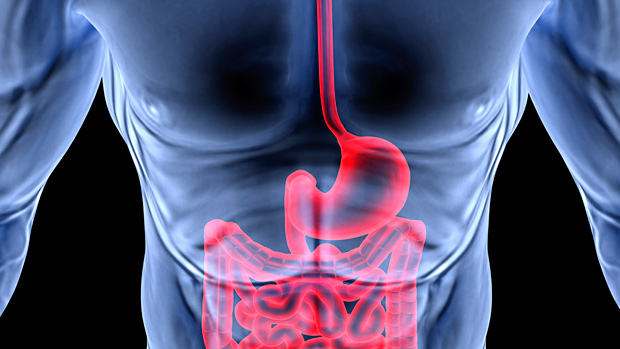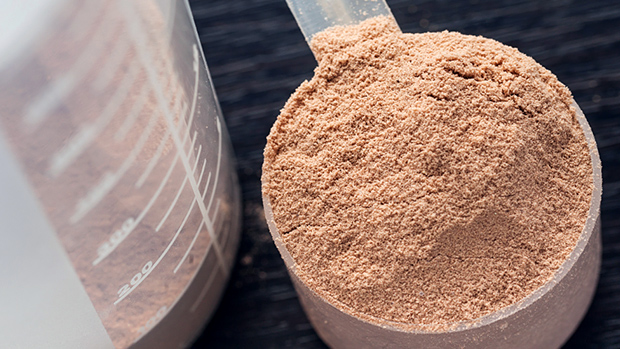It's Not About the Diet
Thousands of diet and exercise programs have been written in the past decades, but are all those programs really necessary? Shouldn't a handful of basic nutrition and training principles work for the vast majority of the population?
There's a basic principle that isn't talked about enough in the diet and muscle-building industry and that is:
Your physiology dictates how well your body will respond to diet and exercise.
Seriously. Don't gloss over that point. Diet and exercise are merely tools that work only as well as your body will allow. This is critical.
The gastrointestinal tract is one such system in the body that, if dysfunctional, can make your fat loss efforts more difficult. Need some examples?
- Gut exposure to any type of antigen (foreign substance leading to antibody production) leads to cytokine production (inflammatory protein messenger), which leads to an increase in ACTH and cortisol production. This can lead to pituitary suppression (lowered Testosterone!), overload of hormone detoxification in the liver, underconversion of T4 to T3, and suppression of secretory IgA, which ultimately leads to an increased sensitivity to antigens, creating a vicious cycle.
- An increase in inflammatory cytokines has been shown to increase lipogenesis (fat storage) and decrease lipolysis (fat breakdown) via a decrease in hormone sensitive lipase.
- Twenty percent of inactive thyroid hormone is converted to active T3 by healthy gut bacterial. Without healthy gut bacteria, you may be missing out on the fat-burning effects of optimal T3 levels.
In other words, if your guts aren't working properly, nothing will.
The GI System

The digestive process doesn't begin in your stomach, or even your mouth. It begins in your brain. When you think of, see, or smell food, the salivation that occurs is evidence that digestion starts as a cerebral process.
But let's talk about the tangible stuff. Here's a breakdown of the digestive tract, what can go wrong, how it can impact your efforts to get ripped for a bodybuilding competition or just shredded for the beach, and what to do about it:
The Stomach
What It Does
The primary role of the stomach in the digestive process is to secrete hydrochloric acid, or HCl. HCl doesn't digest food on its own, but rather creates an environment for digestion to begin.
Hyrdocholoric acid has a number of important functions including, 1) sterilizing food, 2) converting pepsinogen to pepsin, which begins the breakdown of protein, 3) aiding in the absorption of key nutrients such as vitamin B12 and zinc, and 4) preparing the rest of the digestive tract for action.
Specifically without adequate hydrochloric acid, pancreatic enzymes won't be optimally secreted, nor will the gall bladder store adequate amounts of bile to assist in emulsification of fats for digestion.
What Can Go Wrong
The most common problem in today's society with regard to hydrochloric acid secretion is deficiency. A number of factors can contribute to a deficiency of HCl production including aging, infection, and nutrient deficiency (ironically zinc and histidine are required for HCl production, yet zinc and histidine absorption are dependent on adequate amounts of HCl secretion).
What To Do
Firstly, there are a number of ways to assess HCl adequacy ranging from the somewhat strange, to the more scientifically valid.
- HCl test: The first test, and one I don't necessarily recommend for a number of reasons, is the HCl test. According to some people, taking an increasing amount of betaine HCl until a "warming" sensation occurs in the stomach, and then backing off one capsule, indicates one's requirement for HCl supplementation. Though I've seen this work clinically on occasion, it has its flaws.
- Heidelberg test: This test has a little more scientific data behind it and consists of swallowing a capsule, which sends signals back to a machine as to the level of acidity in the stomach. It's a good test, but sometimes difficult to find a practitioner who uses it.
- Blood chemistry: By far the easiest test is to run a standard blood chemistry. There was a group of researchers that correlated the Heidelberg test with protein and globulin markers in the blood, and found a positive correlation between hypochlorhidria, as measured by the Heidelberg machine, and shifts in protein and globulin in blood work.
Specifically, protein above 7.4 or below 6.9 (G/dl), and globulin above 2.8 or below 2.4 (G/100mL), is suggestive of hypochlorhydria. We've found this to be clinically reliable and have observed these markers changing as hydrochloric acid supplementation has been used.
- H.Pylori infection: The World Health Organization considers H.Pylori infections to be one of the most common infections in the world, with an estimated 50% of the population being infected. While third world countries greatly contribute to this statistic, we've seen a large number of H.Pylori infections in our practice.
The most effective test is the Urea Breath Test, which used to be over $1,000 to run, but is now a very affordable $100. It's a pretty nasty infection, even contributing to cardiovascular disease, but is fairly easily eradicated. If you test positive for H.Pylori, eradicating it should be your first priority.
Supplementation
It's not recommended you supplement with HCl without the assistance of a qualified medical professional, despite the ease with which you'll find suggestions online. If you cannot find a qualified practitioner to assist you, you may try supplementing with betain HCl, starting with one capsule or tablet with every meal, and increasing until you feel a "warming" sensation in your stomach, and then backing off one tablet, which will be your maintenance dose for every meal for a period of time.
Ideally you'll be able to back off one tablet at a time until no further HCl supplementation is needed. People who are taking hydrochloric acid shouldn't use ulcer-inducing drugs such as aspirin (or other non-steroidal anti-inflammatory drugs) or alcohol.
Small Intestine
What It Does
The small intestine is where digestion and absorption largely happen. Through the release of pancreatic enzymes, along with bile from the gall bladder, the vast majority of macro and micronutrients are absorbed here.
Through the stimulation of cholecystokinin, bile is secreted into the small intestines to help emulsify ingested fats, and digestive enzymes are secreted by the pancreas including amylase, lipase, zymogens and nucleases.
What Can Go Wrong
As mentioned above, inadequate HCl production will blunt secretion of digestive enzymes and bile, and thus negatively impact absorption. But there are some other things that can go wrong.
Infection of the small intestine leads to a host of negative consequences systemically throughout the body. Infection typically includes parasites, bacteria, or yeast/fungus. This can lead to cytokine production and an increase in cortisol production.
Inflammation of the intestines is thought to negatively impact the microvili, or brush border, which are small extensions of the vili designed to increase the surface area and hence absorption of the small intestines. Food sensitivities and infection are the most common source of inflammation in the small intestines.
Secretory IgA (SIgA) is the dominant immunoglobulin produced in the small intestine and one important component of the local defense against dietary and infectious agents present in the gut lumen. A number of things can decrease SIgA including cortisol, infection, and inflammation, leading to decreased immune protection in the gut and thus increased pathogenesis of mucosal infections.
What To Do
Today one of the most effective tests available is the GI Effects test through MetaMetrix laboratories. This lab has revolutionized stool testing – yes, that's poop testing – by looking for the DNA of a given microbe, rather than the microbe itself.
In other words, it has taken the needle-in-a-haystack method of stool testing and created a way of actually finding the needle in a haystack.
While two types of GI Effects testing is offered, the microbial panel is all you really need. If HCl and enzyme production is adequate, the more expensive and elaborate test isn't necessary.
Supplementation and Recommendations
Again, supplementation without proper assessment isn't recommended. It isn't necessarily damaging, but without proper assessment, you're merely guessing.
To support gall bladder function, the following nutrients may be helpful: dandelion root, milk thistle seed extract, ginger root, phosphatidyl choline, and taurine.
Saccromyces boulardii, a specific strain of yeast, has been shown to increase SIgA levels in the gut. Incidentally, having intercourse two times a week has also been shown to increase SIgA levels over people having sex less than two times per week.
Removal of infection typically requires specific compounds depending on the type of microbe infecting the gut. While numerous natural compounds have been shown to be effective in eradicating certain microbes, clinical experience has shown that parasites typically require pharmaceutical agents.
By far one of the most effective protocols for improving gut function is an elimination diet for a three-week period. While the details are too extensive to get into here, this means eliminating common food antigens (i.e. gluten, dairy, corn, soy, eggs, nightshade vegetables) while focusing on using gut-healing nutrients including: deglycyrrhizinated licorice root, glutamine, flavanoids (catechin), bismuth citrate, gamma-oryzanol, rhubarb officiniale, mastic gum, gamma-oryzanol, marshmallow root, quercitin, grape seed extract, rutin and hesperiden, evening primrose, and enzymes.
Large Intestine
What It Does
By the time food reaches the large intestine, most of the nutrients have been absorbed. The main function of the large intestine is to concentrate waste by reabsorpting water.
The other key feature of the large intestine is the vast population of bacteria that inhabit it. Healthy bacteria function in our large intestine primarily by synthesizing key vitamins (i.e. vitamin K) and assisting in the digestion of polysaccharides.
What Can Go Wrong
The primary malfunction of the large intestine is dysbiosis, or an imbalance of "good" to "bad" bacteria. When this happens, a number of physiological defects can occur, hampering our ability to lose fat.
A little known fact about thyroid hormones is that, in healthy functioning thyroid physiology, approximately 20 percent of our active thyroid hormone (T3) is activated by bacteria in our gut. Specifically, T3 acetic acid and T3 sulfate are metabolized by gut bacteria, creating active T3 hormone that can enter our cells and exert its metabolic effect.
Dysbiosis can also cause an increase beta-glucuronidase activity, which can reverse hormone conjugation by liver, leading to recirculated deconjugated estrogens back into the system, potentially leading to hormone imbalances.
What To Do
Again, one of the most effective gastrointestinal tests available today is the GI Effects test from Metametrix laboratories. If you suspect any type of GI infection, that test is one of the better ones available.
Supplementation and Recommendations
Without testing, a common remedy people use for improving the bacterial balance of their large intestine is the use of probiotics. There are a wide variety of products available on the market today, but selecting professional brands generally means a higher quality product.
Putting It All Together
The first thing to do is try to identify what area of the gut you have a dysfunction in.
| Area | Problem |
| Stomach | Excessive belching or burping Gas immediately following a meal Offensive breath Difficult bowel movement Sense of fullness during and after meals Difficulty digesting fruits and vegetables Undigested foods found in stool Pass large amount of foul smelling gas Stomach pain, burning or aching 1-4 hours after eating Frequent use of antacids Feeling hungry an hour or two after eating Heartburn when lying down or bending forward Temporary relief from antacids, food, milk, carbonation Digestive problems subside with rest and relaxation Heartburn due to spicy foods, chocolate, citrus, peppers, alcohol and caffeine |
| Gall Bladder | Greasy or high-fat foods cause distress Lower bowel gas or bloating several hours after eating Bitter, metallic taste in mouth, especially in the morning Unexplained itchy skin Yellowing cast to eyes Stool color alternates from clay colored to normal brown Reddened skin, especially palms Pass large amount of foul smelling gas Dry or flaky skin and/or hair History of gallbladder attacks or stones |
| Small Intestine | Roughage and fiber cause constipation Indigestion and fullness lasts 2-4 hours after eating Pain, tenderness, soreness on left side under ribcage Excessive passage of gas Nausea and/or vomiting Stool undigested, foul smelling, mucous-like greasy or poorly formed Frequent urination Increased thirst and appetite Difficulty losing weight |
| Large Intestine | Feeling that bowels do not empty completely Lower abdominal pain relief by passing stool or gas Alternating constipation and diarrhea Diarrhea Constipation Hard, dry or small stool Coated tongue or "fuzzy" debris on tongue Pass large amount of foul smelling gas |
The next step is to use objective testing if possible. Guessing should only be reserved for game shows.
When addressing gut function, it's always important to start at the top. Making sure HCl production is adequate, and ruling out an H.pylori infection should come first. Then take a look at every stop on the way down to make sure things are functioning optimally and take the appropriate therapeutic measures as necessary.
Summary
Diet and exercise are merely tools. Effective tools to be sure, but they only work to the degree that your physiology allows them to. The gastrointestinal tract is one such system that if not working properly will make fat loss efforts more difficult, if not impossible in some cases. Fix them and – if everything else is in order – you'll get lean fast!
References
- Crago S et al. Mucosal Antibodies, Food Allergy and Intolerance. 1987:167-89.
- Carins J. et al. Aviat Space Environ Med. 2002.73(12)1203-7.
- Roubenoff R. Molecular basis of inflammation: relationship between catabolic cytokines, hormones, energy balance, and muscle. J Parenter Enteral Nut. (2008) Nov-Dec:32(6):630-2.
- Kossiakoff AA et al. Structural basis for cytokine hormone-receptor recognition and receptor activation. Adv Protien Chem. 1998;52:67-108.
- Excobedo G. Parasite regulation by host hormones: an old mechanism of host exploitation? Trends Parasitol. 2005. Dec;21(12):588-93.
- Rawls WB, Ancona VC. Chronic urticaria associated with hypochlorhydria or achlorhydria. Rev Gastroenterol 1951;18:267.
- Anonymous. A plug for acid therapy. Am J Dig Dis 1948;16:418.
- Mahoney AW and Hendricks DG: Role of gastric acid in the utilization of dietary calcium by the rat. Nutr Metab 16:375-82, 1974
- Jacobs A and Rhodes J: Gastric factors influencing iron absorption in anaemic patients. Scan J Hemat 4:105-10, 1967
- Lehrek M. et al. Serum concentrations of cortisol, interleukin 6, leptin and adiponectin predict stress induced insulin resistance in acute inflammatory reactions. Crit Care. 2008;12(6):R157.




